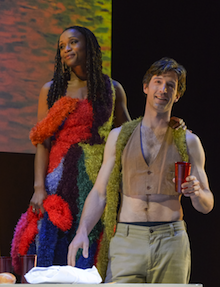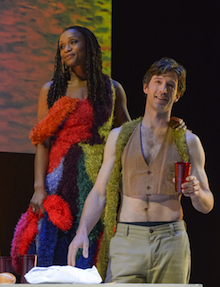
Large splashes of primary colors, undulating waves of energy, exotic landscapes, and bare breasts sensual and provocative: All come to mind at the thought of French painter Paul Gauguin’s oeuvre. All these varied aspects of his supreme artistry, including the controversial writings published in his Intimate Journals, have been brought to life in West Edge Opera’s marvelous production of Fabrizio Carlone’s chamber opera, Bonjour M. Gauguin. Running for only two more performances next weekend, the production is such a success that it demands to be experienced in all its multifaceted wonder.
The production owes its success, first and foremost, to Carlone’s mind-opening score and libretto. Discovered by West Edge Opera General Director Mark Streshinsky during a YouTube surfing session, Bonjour M. Gauguin, which premiered in Venice in 2005, is awash in color and contrast. As Gauguin (sung by baritone Anders Froehlich) and his Inner Voice (soprano Shawnette Sulker) take us from Paris to Tahiti and back again, Carlone’s exotic nine-instrument orchestra, where winds, acoustic guitar, piano, cello, and bass replace the usual complement of violins and violas, paints an aural canvas virtually as arresting as Gauguin’s. Vividly underscoring the magnetism and antagonism of inspiration, ego, and desire, the score’s consistent beauty and expressive instrumental combinations, beautifully rendered by the sfSoundGroup Orchestra under the baton of gifted new-music champion Mary Chun, provide the foundation on which the production soars.
After an abysmal dive into tediously redundant soft-porn distraction in their recent production of Monteverdi’s L’incoronazione di Poppea, West Edge has redeemed itself with Jeremy Knight’s art-centered production and Yannis Adonious’ direction and choreography. Abetted by Streshinsky’s dramatic acumen, the men ensure that projections of Gauguin’s wondrously varied and compelling art works dominate the stage from beginning to end. Rather than employ conventional supertitles, they further underscore the supremacy of Gauguin’s art by projecting quotes from his writings, as well as comments by his fellow artists and contemporary art critics, on the bottom of the canvases.
The score’s consistent beauty and expressive instrumental combinations … provide the foundation on which the production soars.
At times, two art works are projected at once, never more convincingly than at the opera’s end, when Gauguin virtually disappears into one of his creations. Everything we hear and see receives an extra boost of color and impact from the presence of Gauguin’s riveting artistry.
With the only directorial misstep being that Froehlich and other singers occasionally block the projected text — especially unfortunate when dialogue turns from English to French — Adoniou and his Kunst-Stoff Dance Company serve a consistently positive function.

Although, early in the opera, they seemed set to dive into their too-frequent dependence on frenetic gyration, gymnastics, and arms meaninglessly waving about, their interactions with the opera’s five principal singers actually made dramatic sense. Most telling was the way Adoniou deployed his company’s three bare-breasted female dancers, and multiple interactions with a very telling mattress.
Especially remarkable was young dancer Schuyler Wijsen as Gauguin’s son. Poised to enter middle school at Oakland School for the Arts in the fall, the student at Berkeley Ballet Theater is already so relaxed, fluid, and accomplished onstage that it’s easy to expect great things from him in the years ahead.
Dominating the cast, both in height and visual appeal, was strikingly handsome, lean, and buff Froehlich. Trained in ballet, this major casting find easily interacted with and complemented the Kunst-Stoffs, twirling, lifting other dancers, and falling or sliding over the mattress and multiple bodies with ease. His voice may not be ideally polished, with edginess and occasionally rough tone replacing fluidity as he negotiates his middle and high ranges, but no one save a two-faced televangelist will complain about his physical gifts and the way costume designer Shannon Maxham chooses to reveal them.
West Edge Opera has given us a fulfilling feast for the mind and the senses.
Vocally, Sulker as Gauguin’s Inner Voice was the standout. Intentionally moving slowly and with intent while tied to Froehlich as if anchoring the proceedings, she brought to her wide range a weight and gravity that have not always dominated her performances. Several very high notes soared with confidence, strength, and admirable beauty as, amid breasts and buttocks, she gave a marvelous performance that left the audience cheering.
As Narrators 1, 2, and 3, tenor Keith Perry, bass-baritone Paul Murray, and mezzo-soprano Nicole Takesono performed well. Both men showed some strain at the top of their ranges, while Takesono’s instrument tended more toward stolid than opulent, yet their joint evocations of painters, poets, and critics were telling.
“Exoticism is the expression of an individual crisis” is one of the first quotes voiced in the frequently provocative libretto. After pondering whatever truth that thought embodies, the mind flashes to an especially brilliant video projection that constructs one of Gauguin’s nudes right before our eyes while his character explains the rationale behind the painting’s construction. It’s only one of many brilliant flashes of inspiration in West Edge’s must-see realization of Carlone’s captivating opera. How fortunate we are that, in the midst of a season filled with new and modern works from San Francisco Opera and Opera Parallèle, West Edge Opera has given us such a fulfilling feast for the mind and the senses.

